Petunia: species, cultivation at home and diseases

The most diverse in color and common summer plant in gardens, flower beds is petunia. A lush blooming crop is distinguished by a variety of varieties. The types of petunias, the secrets of caring for the culture at home and the possible use of this flower are described in this article.
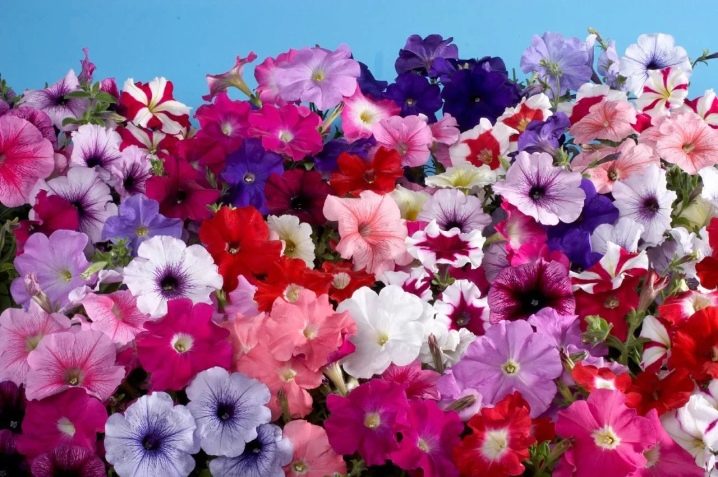
Peculiarities
Petunia is a perennial herbaceous or semi-shrub crop from the Solanaceae family. The homeland of the plant is South America. In the wild, petunia prefers moist forests. Some representatives of this genus are capable of reaching a meter height. Petunia has approximately 30 species. During cold wintering, petunia is grown as an annual crop. It is also popular as an indoor flower. All parts of the plant, with the exception of the buds, are covered with fluff. In the axils of leaves, which are round or oblong in shape, stepchildren grow, used for reproduction of petunias or increasing the splendor of the bush.



The flowers of the culture are large, simple in shape or double, some varieties have corrugated petals. The corolla reaches 7 cm in diameter, in large-flowered plants - 15 cm. The color of the buds is represented by the entire color spectrum, from white to deep purple, similar to a black shade. There are hybrid varieties with two-color buds, a variety of spots, stripes and other patterns. The flowering of petunia is long. After the end of the flowering period, a seed box is formed on the plant, which looks like a bulb. The seeds of petunia are colored brown, small, their germination is maintained for a long period.
Variegated hybrids retain their characteristics when propagated by seeds. These varieties require a vegetative propagation method. The mother bush is kept in a cool room with access to diffused light. In spring, cuttings are harvested.


Types and varieties
Depending on the variety, petunias differ in the growing method: in stationary containers, hanging pots or in open areas. Hybrid petunia was obtained during the selection of various natural crops. The bush is profusely flowering, branched, of medium height, lush due to the growth of a large number of stepchildren. The buds are solitary, the average flower size is 12 cm. The flowering plant has a pleasant light aroma. The flowering period begins in May and ends with the first frost.


Multiflora, or multiflorous, is a type of hybrid petunia. The most unpretentious of the species of this plant. Shades of flowers - pink, white, purple, red, lilac. There are also bicolor specimens. Multiflora can be grown in any soil, it tolerates the rainy season and direct sunlight.


Review of popular varieties of the species.
- "Snowball". A small bush (40 cm) with white plain simple flowers.

- "Fantasy"... The variety is represented by 9 hybrids. The bush is small, no higher than 20 cm, flowers 4 cm in diameter, painted in 2 shades and have the main background of petals and a colorful pharynx. There are red buds with a white base, with dark veins of salmon, raspberry and other shades. The pharynx turns purple, cream, crimson.

- "Alderman"... A bush with small blue flowers, 30 cm high.
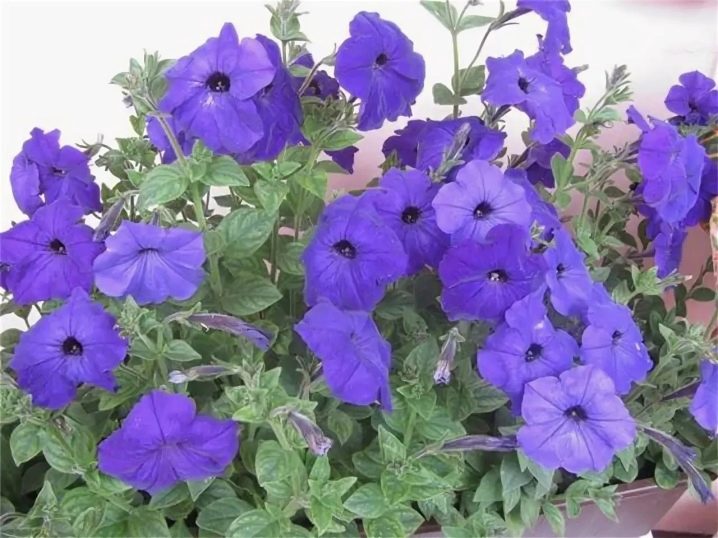
- "Mirage"... Double-flowered culture, including 13 short hybrids. The flowers are medium-sized, up to 9 cm in diameter.Their color can be crimson, burgundy, pink, purple, red, white and others.

- "Plumcrystals"... A small shrub with flowers that gradually fade throughout the flowering period. The color changes from a rich lilac to a pastel shade. The veins on the petals of the bud are pronounced.

- "Tricolor". The main feature of the culture is the self-forming crown. This petunia does not need to be pinched to form a lush bush. Can have pure red, white, blue tint of colors. It tolerates rain well. Flowering ends in the autumn months. Supplied in containers of 6 plants of each shade.

Large-flowered, or Grandiflora, is a group that consists of crops that are capricious to care for, but are distinguished by increased decorativeness. Blooming flowers are up to 15 cm in diameter. On the mother bush, a small number of flower ovaries bloom at the same time, compensating for the shape and color of the petals. Plants are not resistant to rain and wind, the buds are easily injured, and therefore quickly lose their attractiveness.
Grandiflora is grown indoors, on a balcony or in other sheltered places.

Large-flowered petunia is divided into types:
- standard grandiflorum - half a meter high culture, smooth petals, about 10 cm in diameter;
- low - low bush, plant characteristics are similar to the standard subgroup;
- fringed low and standard fringed - crops from 25 to 70 cm in height, a distinctive feature is the unusual shape of the petals;
- superb and superb low - the petals of the flower are smooth with a wide pharynx, the surface is dotted with dark stripes;
- terry - a half-meter plant with double buds, the edge of the petals is smooth.
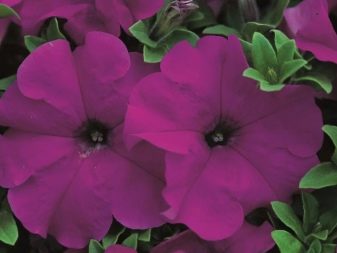

Varieties.
- "Purple Pirouette". A hybrid of a rich purple tone, the flower petals are corrugated with a fringed edge and a white edge. The bush is low - only 25 cm.

- "Triumph". Terry buds of various colors.
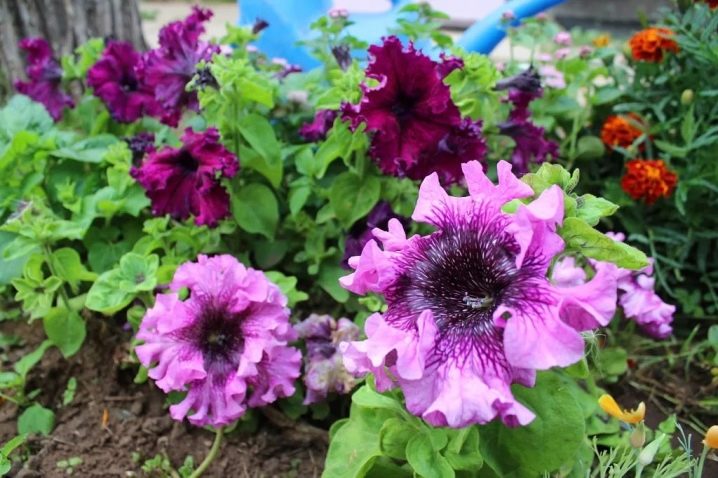
- "Pikoti". The petals are corrugated, with a light edge. The color of the flowers is pink, crimson, blue, red, purple.
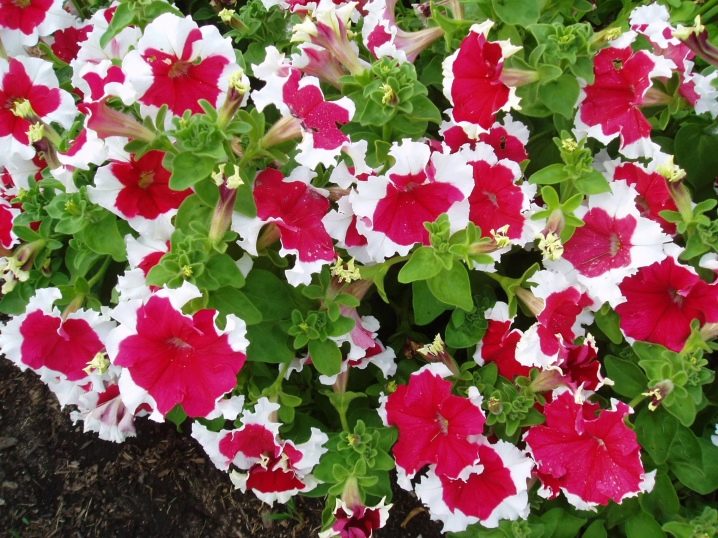
- "Pink Sky". Monochromatic buds with pronounced crimson-purple veins.

- "Hit parade"... Fast flowering short hybrid. Flowers of various colors - from white to blue-violet, saturated shades.

- "Alba fringed" has flowers of a pastel shade, large, with wavy edges, the throat is decorated with bright stripes. The height of the bush is up to 55 cm, blooms until November. It is best planted in open ground with nutritious light soil.
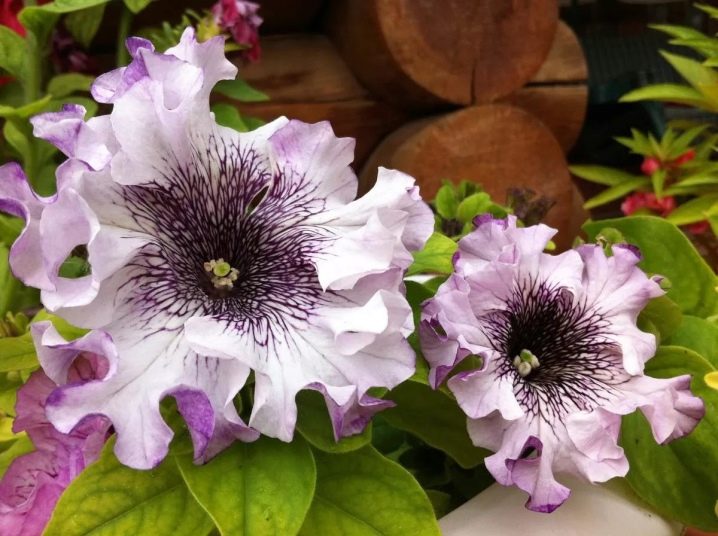
Floribunda - intermediate, rain-resistant... The buds of this petunia do not lose their attractiveness throughout the entire flowering period and under any weather conditions. Floribunda is easy to care for.
For the best possible development of the flower's potential, the plant should be grown in mass plantings, creating a flower garden.
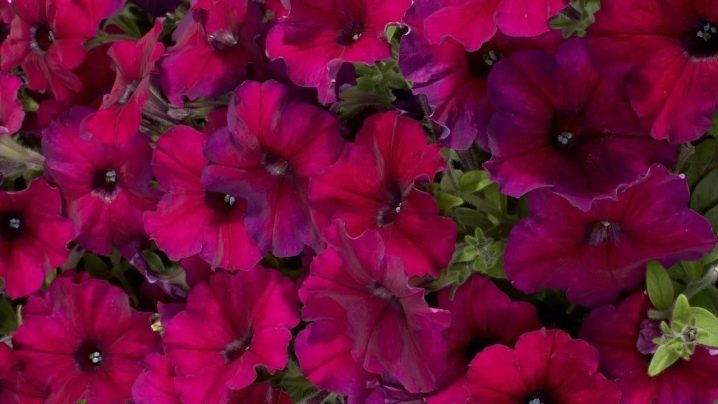
Varieties.
- Celebrity. The culture is tolerant to drought, heat and heavy rainfall. Flowers can be one of 13 color options. The buds are monochromatic, two- or three-colored.
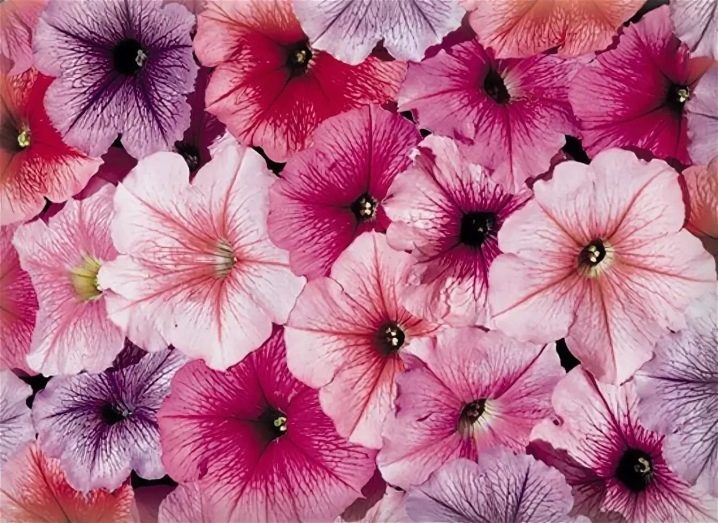
- Sonya. The bushes are not tall, but with expressive flowers. The buds are crimson, purple with stripes, red with a light edge, purple with a white star and others.

Ampelous petunia forms elongated shoots hanging down. The culture is demanding on lighting, nutrient medium, moisture, temperature. It is used to decorate walls, balconies, and is placed in suspended containers.

Varieties.
- "Opera Supreme" - a lush plant with small flowers. The color of the petals is blue, crimson, white, pink.

- "Avalanche" - large-flowered culture. Shoots reach 70 cm in length.

- "Ramblin" Is another large-flowered crop with elongated shoots. The shade of the flowers is varied.

- "Wave" - the plant with the longest shoots among this species, they reach 120 cm. The flowers are medium, painted in purple, pink, blue and purple shades.

- "Rome Magenta" - early flowering variety, resistant to bad weather. Suitable for hanging planters, bulk containers. The flower petals are colored deep purple with a cream edging. Lush flowering, long lasting.

- "Nivola" - large-flowered petunia, semi-ampelous, highly branching bush. Thanks to the selection, Nivola does not form a “bald” center, all its shoots are short, with a large number of stepchildren.
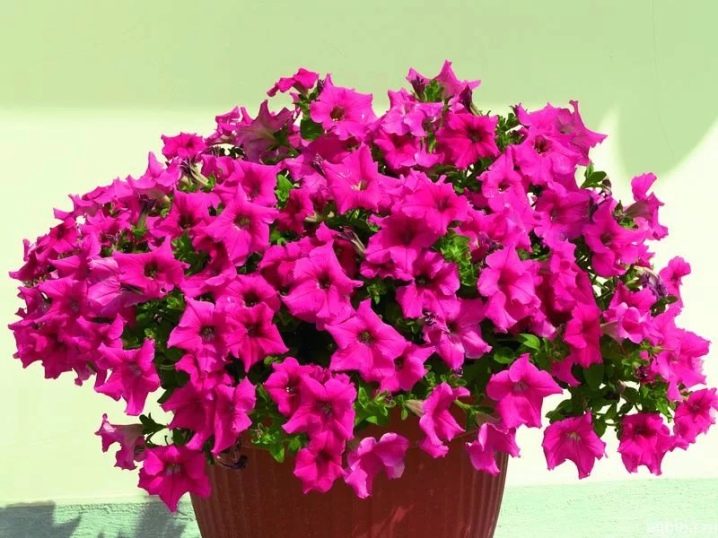
- "Raspberry Ice" forms whips up to 120 cm long, its buds are two-colored: pink center and veins, white petals.
A richly flowering, compact crop suitable for places with short daylight hours.

Cascading petunia is a climbing culture that is confused with ampelous petunia. The difference between the cascade form lies in the development of shoots. The plant grows stems upwards, but due to their heaviness, they fall down. The stems of the cascading petunia are thick, short.

Varieties.
- "Pirouette" - terry culture of various colors. Unpretentious care.

- "Burgundy" - Terry buds, from purple to blue. Abundantly flowering bush.
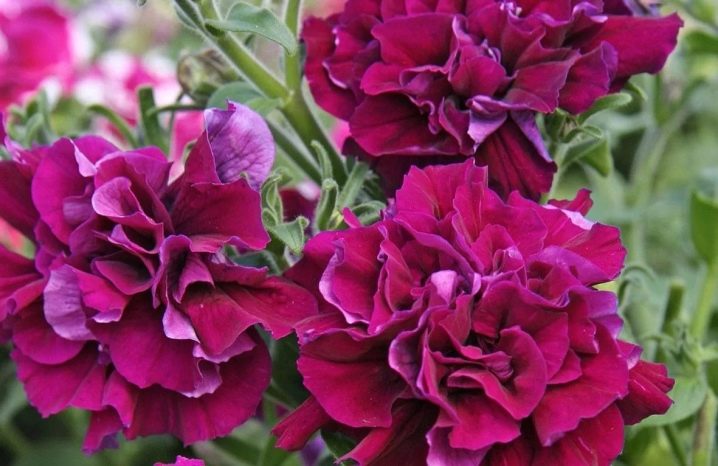
- "Surfinia" - plant "exception to the rule". Does not apply to either ampelous or cascade form. Shoots grow up to 2 meters long. A bush with large buds of various colors.

- "Tornado" - a culture with meter shoots and large buds. Unpretentious care.

- "Orchid Mist" - buds of white-pink scale, double, large.
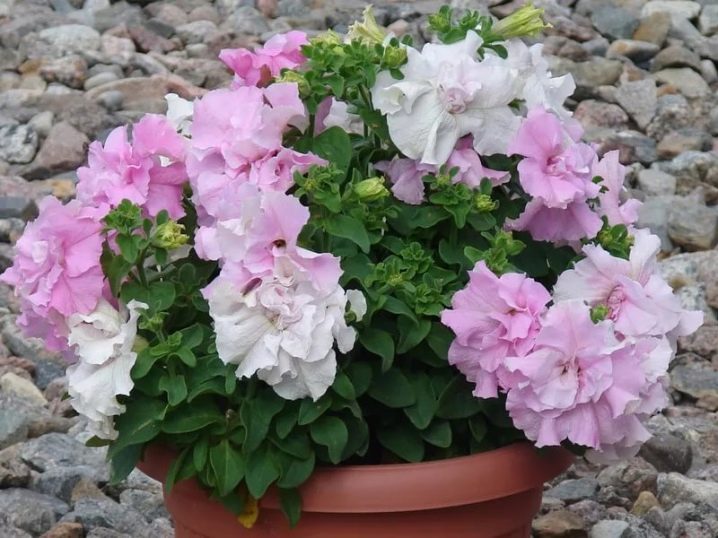
- "La Gioconda" - flowers are medium, no more than 6 cm, petals are painted in white, purple, pink and other colors, including orange.

Garden petunia is called balcony or ampelous crops. Consists of varieties with flexible shoots, prone to growth mainly downward. Garden petunias are fast growing and weather resistant.

Varieties.
- Conchita. The flowers of the culture are similar in shape and size to the calibrachoa buds. Buds of various shades, 5 cm in diameter.
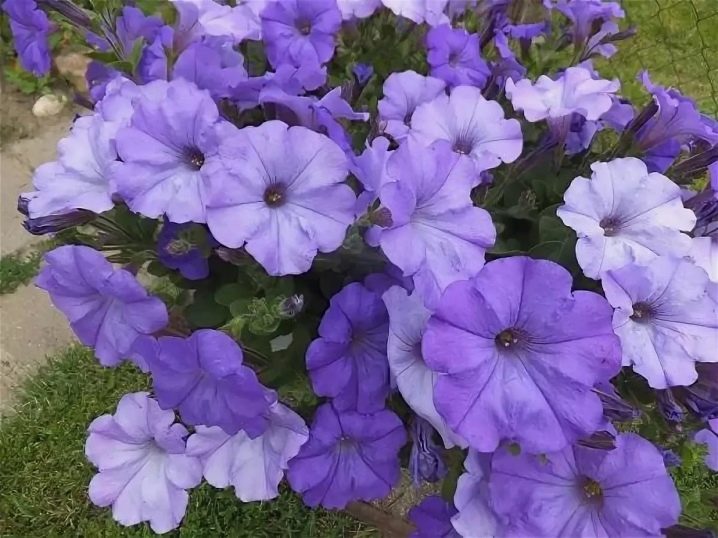
- "Tumbelina". Terry petunia originated in Japan.

- "Surfinia". Large-flowered plant. Hybrids - Pink Mini, Mini Pearl. The diameter of the buds is no more than 5 cm. The flower petals are painted in a variety of colors, including yellow, orange shades of various saturation.

- "Silvia" - a culture with flowers of a rich fuchsia shade. The bush is 35 cm tall, resistant to bad weather, suitable for growing in open spaces, parks, gardens, balcony boxes.

- "Rose" - This petunia looks like the pink sky variety. It is used for landscaping balcony tubs, flowerpots, it is planted as a border composition, a rabatka. Resistant to the vagaries of the weather, blooms before frost.
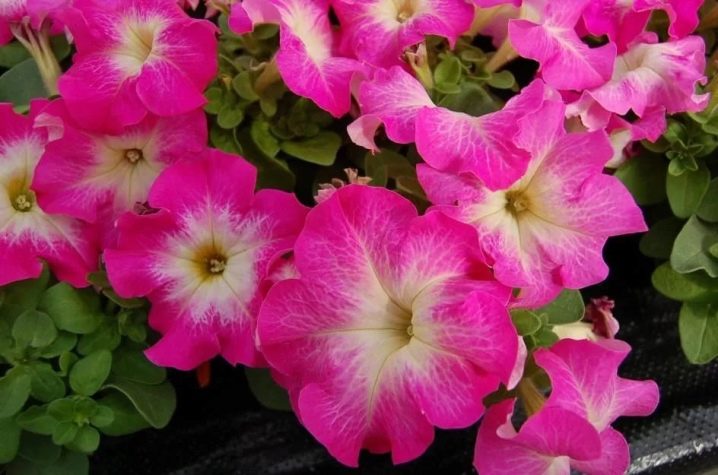
Home care secrets
Petunias are easily grown from seeds and do not require special care, the main thing is to adhere to the recommendations in order to properly grow the plant at home or in the garden and preserve it in the winter if the culture is perennial.
Petunia is a sun-loving culture. Some varieties are able to develop favorably in partial shade conditions. Open locations, balcony tubs and flowerpots must be protected from the wind. At home, flower pots are placed on the windowsill, ampelous varieties are placed a meter from the window or closer, without access to drafts. When finding a flower on the south window, it is worth taking care about the shelter of the plant from direct sunlight during the flowering culture.
For petunias, a special soil for flowering or garden plants is suitable. The main thing is that it is light and loose, permeable to air and moisture. You can achieve this state of the soil with the help of vermiculite or sphagnum moss. When self-manufacturing the substrate, it is worth using peat, humus, washed sand, vermiculite in the proportion: 2: 2: 1: 1.
The acidity level of the earth should be neutral, slightly acidic or slightly alkaline. If the soil is too acidic, it is worth “extinguishing” it with lime, and if it is alkaline, then spill it with water and citric acid.


The plant needs regulated watering. The water is used soft, separated, at room temperature. It is advisable not to flood the culture, especially since petunias calmly tolerate short-term drying of the soil. With excessive soil moisture, there is a likelihood of developing fungal diseases. In closed containers, there must be drain holes. If water is stagnant in the pot or the substrate is too wet, it is recommended to remove the plant from the pot, dip it with an earthen lump with newspaper or dry cloth to remove excess water. The plant can be left outdoors for a couple of hours to dry out a little. After all the manipulations, you need to place the petunia in its original place and do not water the plant until the soil is at least half dry.
Petunias do not require high humidity. It is recommended to spray the plant only a few times a week in the morning or evening hours, but in general you can do without it. It is advisable to protect the plant from dust by wiping the leaves as they become dirty with a warm, wet cloth.

Reproduction
There are two ways to propagate petunia: germinate seeds and root cuttings. The latter are distinguished by easy care for the seedlings.
Seeds
When planting seeds, an additional light source will be required - phytolamp. Gardeners prefer to plant seeds in mid-March, but it should be borne in mind that daylight hours are still short this month, therefore, seeds should be sown in large quantities to obtain a sufficient amount of planting material.
It is necessary to prepare the substrate for sowing. Ready loose soil is taken or compiled independently from humus, peat, sand, leafy earth in a ratio of 2: 2: 1: 2. Ready soils can be replaced with peat tablets, which are compressed peat substrate. They act as a seedling pot and create a breeding ground for them. The prepared potting mix is filled into seedling containers made of coconut fiber or plastic.
It is desirable that the topsoil be sifted earth. The day before sowing the seeds, the soil is watered with soft water.


The seeds are mixed with dry sand and spread over the prepared substrate. At the end of sowing, use a spray gun to moisten the soil surface. Each container is individually or entirely covered with glass. The seed containers are stored in a warm place with diffused light. The air temperature should be +20. +23 degrees. Seedlings will appear in about a week. When the seedlings have sprung up, it is necessary to ventilate the greenhouse every day in the morning or in the evening and moisten the top layer of the substrate. It is recommended to spray seedlings solution of potassium permanganate.
When 4 true leaves have formed on the seedlings, they are picked. Before the procedure, the soil must be moistened.

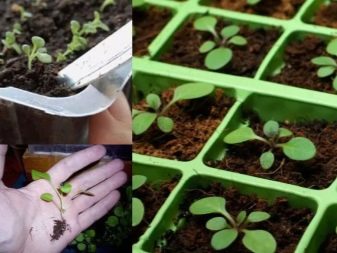
The plant must be clamped with a stick or hands, without squeezing the trunk. Each sprout must be pulled out of the pot without touching the earthen ball and trying not to injure the young plant. The sprouts should be dived into individual containers filled with a substrate.
When all the manipulations are completed, each plant is well watered, covered with paper cups or sheets for several days.
During this period, you should be extremely careful about caring for seedlings. The soil should be moderately moist. The frequency of watering depends on the location of the dived sprouts. At high air temperatures, watering the plants will need to be small twice a day. The topsoil is loosened systematically to provide oxygen access to the roots.

After 7 days, young seedlings begin to fertilize once a week, alternating root and surface fertilization methods. Kemira, Solution, and other special ready-made fertilizers are suitable as nutrient mixtures.
Petunia Grandiflora blooms 3 months after sowing, Multiflora - after 2 months. Before planting a plant in open ground, it must go through a period of adaptation. The culture pots are placed outdoors or in a cool place for a couple of hours every day.

Cuttings
This method is only suitable for terry, calibrachoa, ampelous crops. The first group reproduces in the last week of the winter month or at the beginning of spring, the rest - all year round, but with supplementary lighting with a phytolamp.
The step-by-step guide to propagating petunias by cuttings is pretty simple. To begin with, the tops with 4 leaf plates are cut off on the mother plant. The leaves on the handle are removed, with the exception of the top two, which, in turn, are shortened by half. The finished fragments are planted in a seedling substrate. The surface of the substrate is sprinkled with a layer of sand 2.5 cm thick, before that it has been watered with a fungicide solution.
A distance of 2 cm is maintained between the cuttings. The containers are covered with glass. The use of growth stimulants is not recommended. The soil must be moistened all the time. Terry ampelous culture takes root after 7 days, calibrachoa - after 2 weeks.


When the roots reach 1.5 cm in length, the plants dive into individual containers with a diameter of 5 cm. To form a lush bush, petunias are pinched over a 4-5 leaf plate. The stems left after the pinching can be used as new cuttings. After 15 days, if necessary, pinch the plant again. After 1.5 months, the culture is transplanted into larger containers. Care for the cuttings should be the same as for the seedlings.
It should be borne in mind that ampelous plants, calibrachoa, require free space, therefore, it is recommended to hang containers.

Diseases and pests
Petunia is susceptible to the development of fungal diseases, insect pests, diseases associated with improper care, lack of nutrients.
- Blackleg affects young plants and seedlings from the moment the seed germinates. The root collar of the plant acquires a dark shade, close to black, and a constriction forms on the lower part of the shoot. When the culture is in a humid environment, after 5 days, the affected area softens, the stem breaks, the flower dies.
The cause of the black leg is the dense sowing of seeds, high humidity of the air, substrate, and increased acidity of the soil mixture.
For treatment, you need to remove the affected areas of the petunia, pour it with Bordeaux 1% liquid or use potassium permanganate for this. It is better to plant petunia seeds in peat tablets, as this material is sterile.

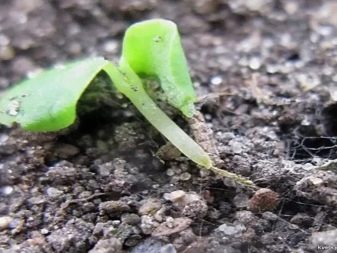
- Gray rot forms brown spots covered with gray down on leaves, shoots, buds. The flower begins to fade, then rots, leaving behind an unpleasant mass. Gray rot develops due to thickening of plantings, high humidity, low temperatures, excess nitrogen or lack of sun. In order to avoid infection, you need to regularly inspect the crops, remove the remnants of dead shoots and flowers, treat the affected areas, increase the level of phosphorus and potassium in the soil mixture. For treatment, you can use drugs "Skor", "Maxim" and "Integral".


- White rot forms wet spots on the leaf plates of the plant, which later become covered with whitish mycelium at high humidity. Infected areas soften, turn white. The mycelium develops inside and outside the culture. The cause of the onset of the disease is excess moisture, low temperature, preservation of dead plant parts on the bush. White rot spreads by spores, settling on clothes, the hands of the gardener while caring for flowers. To cure petunia, it is necessary to liming the soil, replacing the soil, and removing the infected parts of the plant. Then treat the culture with special preparations "Fitosporin", "Integral" and others.

- Late blight... With this ailment, the root collar, the base of the stem becomes brown and decays over time, the petunia stretches, withers, dies. Late blight occurs when the bush is placed in a cold room with high humidity and when the soil is flooded. Wrestling: airing of seedlings, preventive treatment of the substrate with the preparations "Profit", "Ridomil MC" and so on. The main active substances for combating the disease are oxadixil, mancozeb, metalaxil.
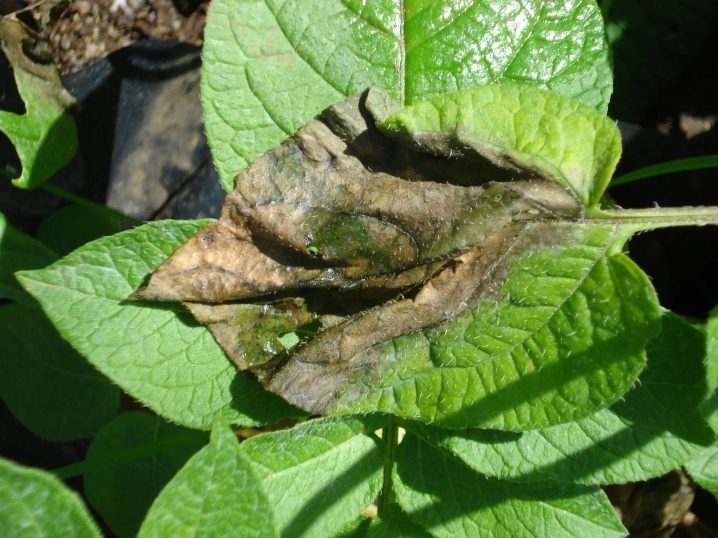
- Brown spot forms rust-like spots on the leaves. At first, the infected areas are small, in the form of a dot, then they are transformed into spots. Mycelium forms in whitish areas. Infected parts of the flower wither and dry out. Brown spot is the result of mechanical damage to plant tissues and high humidity. To avoid this petunia disease, you need to follow the rules of agricultural technology, carry out the processing of the culture preparations with copper "Kartotsid", "Oxyhom" or use copper oxychloride.

- Powdery mildew first it appears on the leaves as a white bloom, then it is thrown onto the inner side of the leaf and the stem of the plant, eventually covering the entire flower. White bloom disrupts the function of photosynthesis, due to which the leaf plates curl, dry out, and the culture does not bloom. Powdery mildew is especially dangerous for seedlings. The fight against it is to remove all infected shoots, buds, leaves, followed by burning this plant material. Reducing nitrogen fertilization will also help defeat the disease. The plant needs to be sprayed with drugs "Topaz", "Skor", "Previkur" and others.

- Aphids cause chlorosis in a plant, deformation of shoots, leaves, their wilting. The petals of the buds are covered with dew with a sooty fungus and wither. Aphids carry viral diseases. If the petunia is planted in the garden, then in order to get rid of the aphids, it is advisable to attract ladybirds to the plants, and also regularly perform a complete cleansing of the bush with a damp cloth or warm water with laundry soap. Spraying crops will also help "Aktaroy", "Fufanon", "Decis".

- Whitefly. Leaves and shoots are covered with yellowish spots, curl slightly. With severe infection, parts of the plant are deformed and dry out. When the plant moves, small flying white insects are seen flying from leaf to leaf. Regular washing of the flower with soapy water, cleaning the soil from weeds will help get rid of the whitefly. It is possible to place potted crops in a cold place, catching "butterflies" using traps. Treatment with drugs Aktar, Fufanon, Apploud, Mospilan will also destroy these insects.

- Thrips leaves behind pollen spilling out from the stamens of the bud. When petunia is damaged by this pest, the anther becomes dried out, brownish, the base of the pistil is thickened. Leaves are covered with white or black bloom, specks. Small punctures are visible on the leaves with yellowish spots, stripes and other patterns. Over time, the lesions merge, the leaf becomes silvery white. The puncture sites darken. Prevention: removal of dead plant matter, weeds. In case of severe damage, the upper part of the plant and all affected areas are cut off. The culture is being processed with drugs Intavir, Akarin, Aktara, Fitoverm, Vertimek.

- Spider mite covers the petunia with small yellow dots. The leaf plate brightens, dries up over time, a cobweb forms on it. To combat the problem, you need to improve flower nutrition, regularly ventilate the plant, adjust watering, and destroy weeds. During the growth period, you can do it processing "Akarin", "Fitoverm", "Demitan" or other drugs.

Application in landscape design
Petunia is very widely used in open mass plantings, creating "carpet paths", border compositions.They plant it on the balcony in a box, in gardens and in the country along the fence, in wide flowerpots and hanging baskets.



For information on how to grow petunias, see the next video.







































































































The comment was sent successfully.